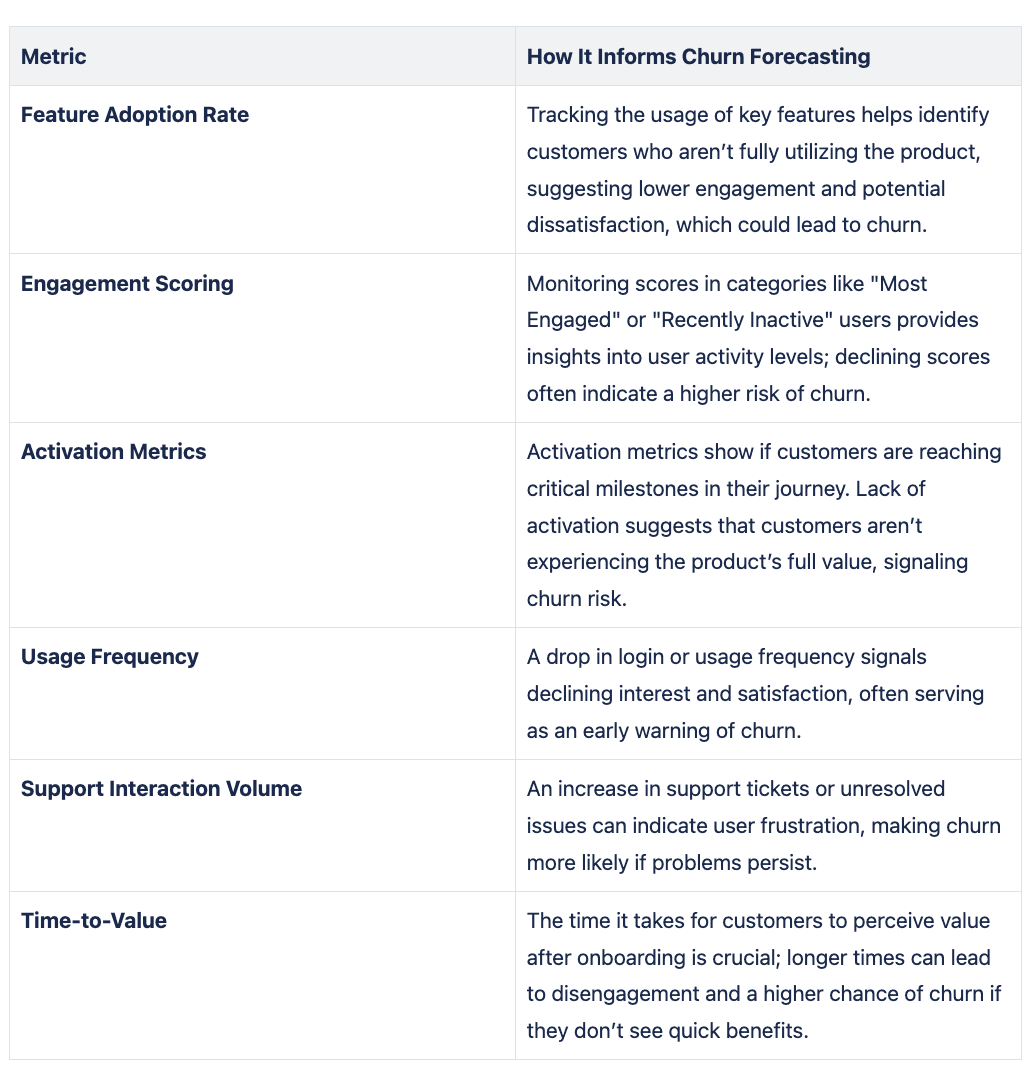Product Engagement Metrics
Churn Control
The Why & So What of Product Analytics
Product Engagement Metrics
Churn Control
The Why & So What of Product Analytics
Forecasting Churn
Using Engagement Data for Better Retention
Who wants to look into the future? Everyone, that’s who. In terms of churn, knowing who might leave before they do can be a game-changer. Knowing the customers who might leave you gives you the chance to intervene and retain them. With Accoil Analytics, you can look into the future and prevent any nightmare scenarios.s
Why Churn Forecasting is Important
In any business, if you can reduce losses you can maximize growth. In essence, churn forecasting helps you to:
Identify your at-risk customers early: By knowing who’s likely to leave, you can find out why they want to leave.
Allocate your resources efficiently: You can focus your time and efforts on the customers who are most likely to leave, rather than spreading your resources too thinly.
Enhance your customers’ experience: By finding out where the weakest points in your product use are, you can improve the overall experience for your customer base. In short, everyone wins.
The Role of Product Engagement Data
Product engagement data is a treasure chest of insights. This data tells you how customers are interacting with your product, what features they value, and where they might be having problems. Accoil Analytics gives you the tools to dive deep into this information. This all means you can predict churn precisely, and from a long way off. Here’s how:

Building a Churn Prediction Model
Accoil Analytics allows you to create what we call a churn prediction model. This aggregates all the metrics above and provides a churn risk score for each customer. Clever, eh? Here’s a little guide to creating one:
Collect all your Data: Start by collecting product engagement data, like usage frequency, feature adoption, and engagement scores.
Analyze emerging Patterns: Use Accoil Analytics to find patterns in the data. Look in particular for common traits among customers who have previously churned, such as lowered engagement or low feature adoption.
Assign Scores: Based on these patterns, assign a churn-risk score to each customer. This score will show their likelihood of leaving, so allowing you to focus in on these high-risk customers.
Take Action: Once you have your churn-risk scores, you’re ready to take action. This might include reaching out to customers personally, offering them more support, or incentivizing them to use more key features.
The Bottom Line: Stay Ahead with Proactive Forecasting
Battling churn might sound daunting. But by using Accoil Analytics to forecast churn, you can stay ahead of potential losses and — crucially — turn customers at risk of leaving into loyal advocates. What’s more, it’s win-win. By taking these simple steps, you’ll not only lower churn but also build stronger, longer-lasting customer relationships. Who knows? One day you might even enjoy a pint with them.
Content
Forecasting Churn
Using Engagement Data for Better Retention
Who wants to look into the future? Everyone, that’s who. In terms of churn, knowing who might leave before they do can be a game-changer. Knowing the customers who might leave you gives you the chance to intervene and retain them. With Accoil Analytics, you can look into the future and prevent any nightmare scenarios.s
Why Churn Forecasting is Important
In any business, if you can reduce losses you can maximize growth. In essence, churn forecasting helps you to:
Identify your at-risk customers early: By knowing who’s likely to leave, you can find out why they want to leave.
Allocate your resources efficiently: You can focus your time and efforts on the customers who are most likely to leave, rather than spreading your resources too thinly.
Enhance your customers’ experience: By finding out where the weakest points in your product use are, you can improve the overall experience for your customer base. In short, everyone wins.
The Role of Product Engagement Data
Product engagement data is a treasure chest of insights. This data tells you how customers are interacting with your product, what features they value, and where they might be having problems. Accoil Analytics gives you the tools to dive deep into this information. This all means you can predict churn precisely, and from a long way off. Here’s how:

Building a Churn Prediction Model
Accoil Analytics allows you to create what we call a churn prediction model. This aggregates all the metrics above and provides a churn risk score for each customer. Clever, eh? Here’s a little guide to creating one:
Collect all your Data: Start by collecting product engagement data, like usage frequency, feature adoption, and engagement scores.
Analyze emerging Patterns: Use Accoil Analytics to find patterns in the data. Look in particular for common traits among customers who have previously churned, such as lowered engagement or low feature adoption.
Assign Scores: Based on these patterns, assign a churn-risk score to each customer. This score will show their likelihood of leaving, so allowing you to focus in on these high-risk customers.
Take Action: Once you have your churn-risk scores, you’re ready to take action. This might include reaching out to customers personally, offering them more support, or incentivizing them to use more key features.
The Bottom Line: Stay Ahead with Proactive Forecasting
Battling churn might sound daunting. But by using Accoil Analytics to forecast churn, you can stay ahead of potential losses and — crucially — turn customers at risk of leaving into loyal advocates. What’s more, it’s win-win. By taking these simple steps, you’ll not only lower churn but also build stronger, longer-lasting customer relationships. Who knows? One day you might even enjoy a pint with them.